Dwell Fatigue Crack Growth Behavior of CP-Ti TA2 Welded Joint at 25 °C and 200 °C
Abstract
1. Introduction
2. Methods
2.1. Experiments
2.2. Finite Element Simulation
3. Results
3.1. The Effect of Room-Temperature Dwell on FCG Behavior
3.1.1. FCG Rate Analysis at the Temperature of 25 °C
3.1.2. FEM Results Analysis at a Temperature of 25 °C
3.2. The Effect of Dwell at 200 °C on FCG Behavior
3.2.1. FCG Rate Analysis at the Temperature of 200 °C
3.2.2. FEM Results Analysis at the Temperature of 200 °C
3.3. Fracture Surface Analysis
3.3.1. SEM Study at the Temperature of 25 °C
3.3.2. SEM Study at the Temperature of 200 °C
4. Conclusions
- At a relatively low load ratio and room temperature, dwell has little effect on the FCG behavior of the TA2 weld joint. At 200 °C, the FCG rate is significantly accelerated by dwell. Regardless of temperature, the increase in the FCG rate resulting from dwell becomes more apparent at the higher load ratio.
- Dwell leads to a reduction of the stress level at the crack tip and an increase in plastic deformation. With the increase in the load ratio and dwell temperature, creep deformation is increased, thereby leading to a more pronounced dwell effect.
- At room temperature and a low load ratio, dwell has little effect on the morphology of the fracture surface. At a high load ratio, a small number of secondary cracks and cavities appear on the fracture surface. At a temperature of 200 °C, the plastic deformation trace is more significant. With the increase in load ratio, the number of creep cavities and secondary cracks increases.
Author Contributions
Funding
Data Availability Statement
Conflicts of Interest
References
- Cuddihy, M.A.; Stapleton, A.; Williams, S.; Dunne, F.P.E. On cold dwell facet fatigue in titanium alloy aero-engine components. Int. J. Fatigue 2017, 97, 177–189. [Google Scholar] [CrossRef]
- Wu, Z.; Kou, H.; Chen, N.; Xi, Z.; Fan, J.; Tang, B.; Li, J. Recent developments in cold dwell fatigue of titanium alloys for aero-engine applications: A review. J. Mater. Res. Technol. 2022, 20, 469–484. [Google Scholar] [CrossRef]
- Lepore, M.A.; Maligno, A.R.; Berto, F. A unified approach to simulate the creep-fatigue crack growth in P91 steel at elevated temperature under SSY and SSC conditions. Eng. Fail. Anal. 2021, 127, 105569. [Google Scholar] [CrossRef]
- Zhao, J.; Mo, T.; Nie, D. The occurrence of room-temperature creep in cracked 304 stainless steel specimens and its effect on crack growth behavior. Mater. Sci. Eng. A 2008, 483, 572–575. [Google Scholar] [CrossRef]
- Wang, K.; Wang, F.; Cui, W.C.; Tian, A.L. Prediction of cold dwell-fatigue crack growth of titanium alloys. Acta Metall. Sin. 2015, 285, 619–627. [Google Scholar] [CrossRef]
- Gustafsson, D.; Moverare, J.J.; Johansson, S. Influence of high temperature hold times on the fatigue crack propagation in Inconel 718. Int. J. Fatigue 2011, 33, 1461–1469. [Google Scholar] [CrossRef]
- Gustafsson, D.; Moverare, J.J.; Simonsson, K. Fatigue crack growth behavior of Inconel 718—The concept of a damaged zone caused by high temperature hold times. Procedia Eng. 2011, 10, 2821–2826. [Google Scholar] [CrossRef]
- Lu, Y.L.; Chen, L.J.; Liaw, P.K. Effects of temperature and hold time on creep-fatigue crack-growth behavior of HAYNES alloy. Mater. Sci. Eng. A 2006, 429, 1–10. [Google Scholar] [CrossRef]
- Iyer, A.H.S.; Stiller, K.; Leijon, G. Influence of dwell time on fatigue crack propagation in Alloy 718 laser welds. Mater. Sci. Eng. A 2017, 704, 440–447. [Google Scholar] [CrossRef]
- Bassi, F.; Foletti, S.; Lo Conte, A. Creep fatigue crack growth and fracture mechanisms of T/P91 power plant steel. Mater. High. Temp. 2015, 32, 250–255. [Google Scholar] [CrossRef]
- Tanaka, H.; Yamada, T.; Sato, E.; Jimbo, I. Distinguishing the ambient-temperature creep region in a deformation mechanism map of annealed CP-Ti. Scrip. Mater. 2006, 54, 121–124. [Google Scholar] [CrossRef]
- Yamada, T.; Kawabata, K.; Sato, E.; Sato, E. Presences of primary creep on various phase metals and alloys at ambient temperature. Mater. Sci. Eng. A 2009, 387, 719–722. [Google Scholar] [CrossRef]
- Oberson, P.G.; Wyatt, Z.W.; Ankem, S. Modeling interstitial diffusion controlled twinning in alpha titanium during low-temperature creep. Scrip. Mater. 2011, 65, 638–641. [Google Scholar] [CrossRef]
- Oberson, P.G.; Ankem, S. The effects of time-dependent twinning on low temperature (<0.25*Tm) creep of an alpha-titanium alloy. Int. J. Plast. 2009, 25, 881–900. [Google Scholar]
- Li, J.; Lu, L.; Zhang, P.; Miao, X.T.; Chang, L.; Zhou, B.B.; Wang, Y.Z.; He, X.H.; Zhou, C.Y. Effect of cold creep on fatigue crack growth behavior for commercial pure titanium. Theor. Appl. Fract. Mec. 2018, 97, 177–188. [Google Scholar] [CrossRef]
- Su, C.Y.; Zhou, C.Y.; Lu, L.; Li, J.; Sun, P.Y. Effect of temperature and dwell time on fatigue crack growth behavior of CP-Ti. Metals 2018, 8, 1031. [Google Scholar] [CrossRef]
- Chang, L.; Zhou, C.Y.; Peng, J.; Li, J.; He, X.H. Creep behavior of CP-Ti TA2 at low temperature and intermediate temperature. Rare Met. Mater. Eng. 2017, 7, 1463–1468. [Google Scholar]
- Lu, L.; Li, J.; Su, C.Y.; Sun, P.Y.; Chang, L.; Zhou, B.B.; He, X.H.; Zhou, C.Y. Research on fatigue crack growth behavior of commercial pure titanium base metal and weldment at different temperatures. Theor. Appl. Fract. Mec. 2019, 100, 215–224. [Google Scholar] [CrossRef]
- ASTM E647-15; Standard Test Method for Measurement of Fatigue Crack Growth Rates. American Society for Testing and Materials: West Conshohocken, PA, USA, 2015.
- Chaboche, J.L. Time-independent constitutive theories for cyclic plasticity. Int. J. Plast. 1986, 2, 149–188. [Google Scholar] [CrossRef]
- Sun, P.Y.; Zhu, Z.K.; Su, C.Y.; Lu, L.; Zhou, C.Y.; He, X.H. Experimental characterisation of mechanical behavior for a TA2 welded joint using digital image correlation. Opt. Laser. Eng. 2019, 115, 161–171. [Google Scholar] [CrossRef]
- Ravi Chandran, K.S. A new approach to the mechanics of fatigue crack growth in metals: Correlation of mean stress (stress ratio) effects using the change in net-section strain energy. Acta Mater. 2017, 135, 201–214. [Google Scholar] [CrossRef]
- Peng, J.; Zhou, C.Y.; Dai, Q.; He, X.H. The temperature and stress dependent primary creep of CP-Ti at low and intermediate temperature. Mater. Sci. Eng. A 2014, 611, 123–135. [Google Scholar] [CrossRef]
- Chen, Z.; Holdsworth, S. High-R low growth rate fatigue crack propagation at elevated temperatures. Int. J. Fatigue 2018, 106, 114–122. [Google Scholar] [CrossRef]
- Evans, W.J.; Bache, M.R. Dwell-sensitive fatigue under biaxial loads in the near-alpha titanium alloy IMI685. Int. J. Fatigue 1994, 16, 443–452. [Google Scholar] [CrossRef]

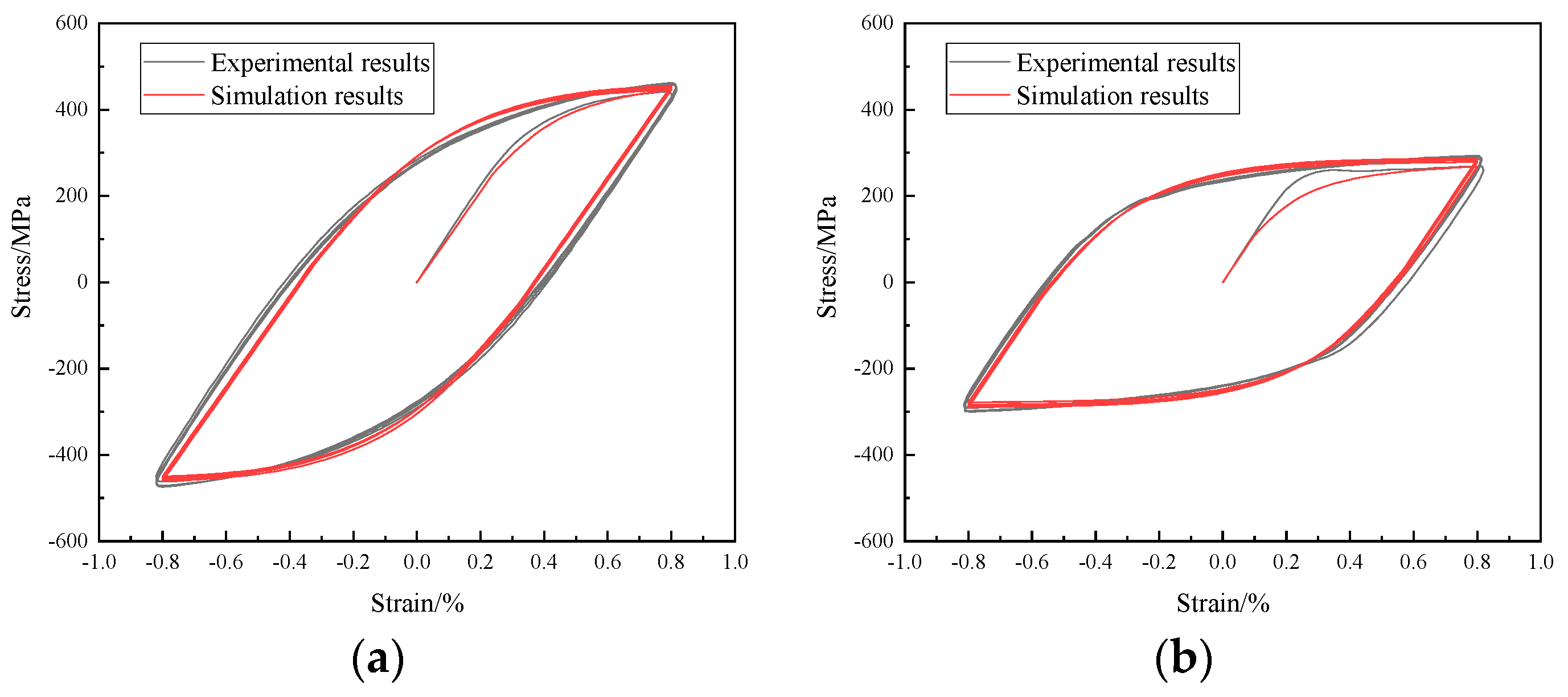
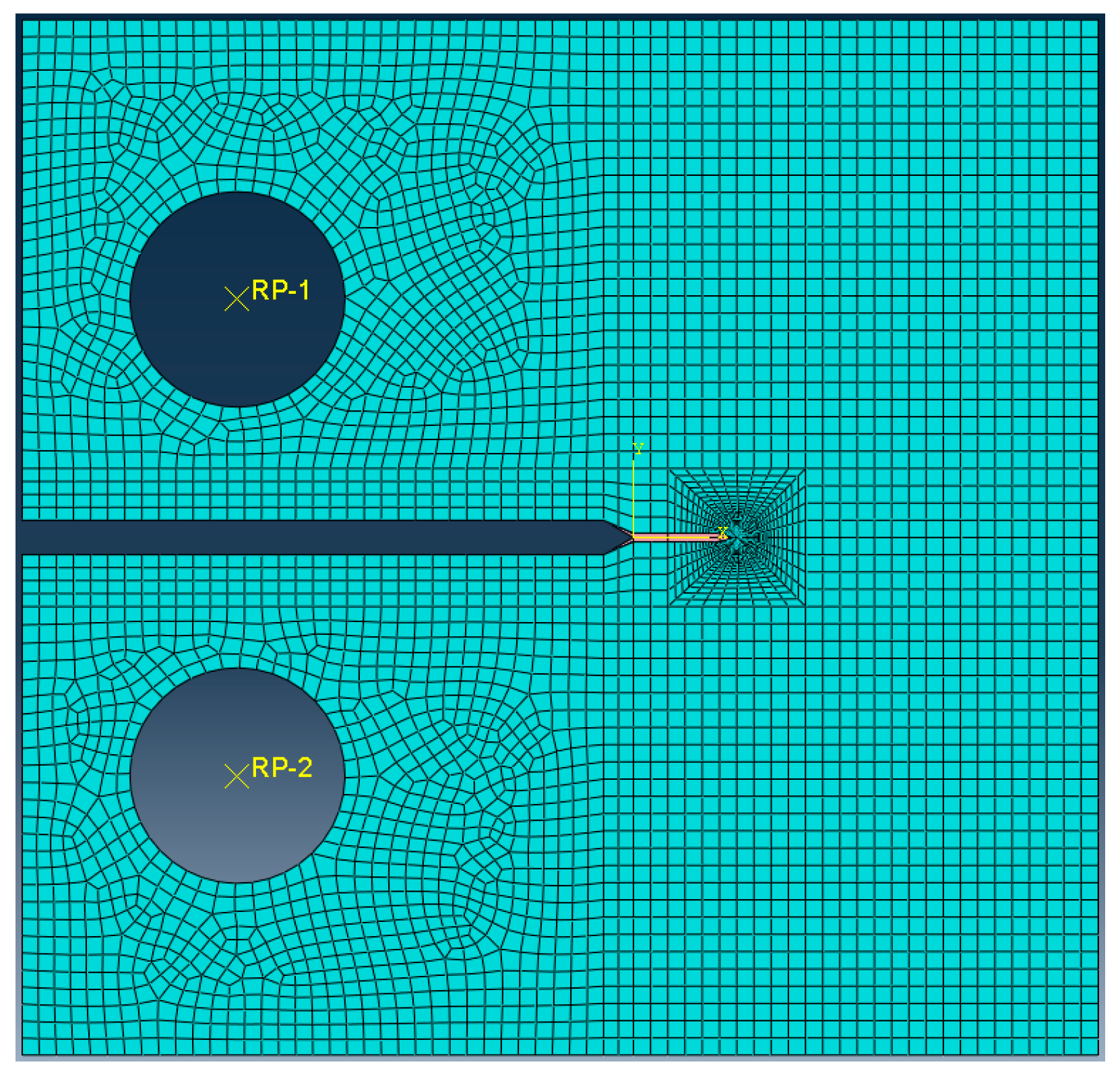


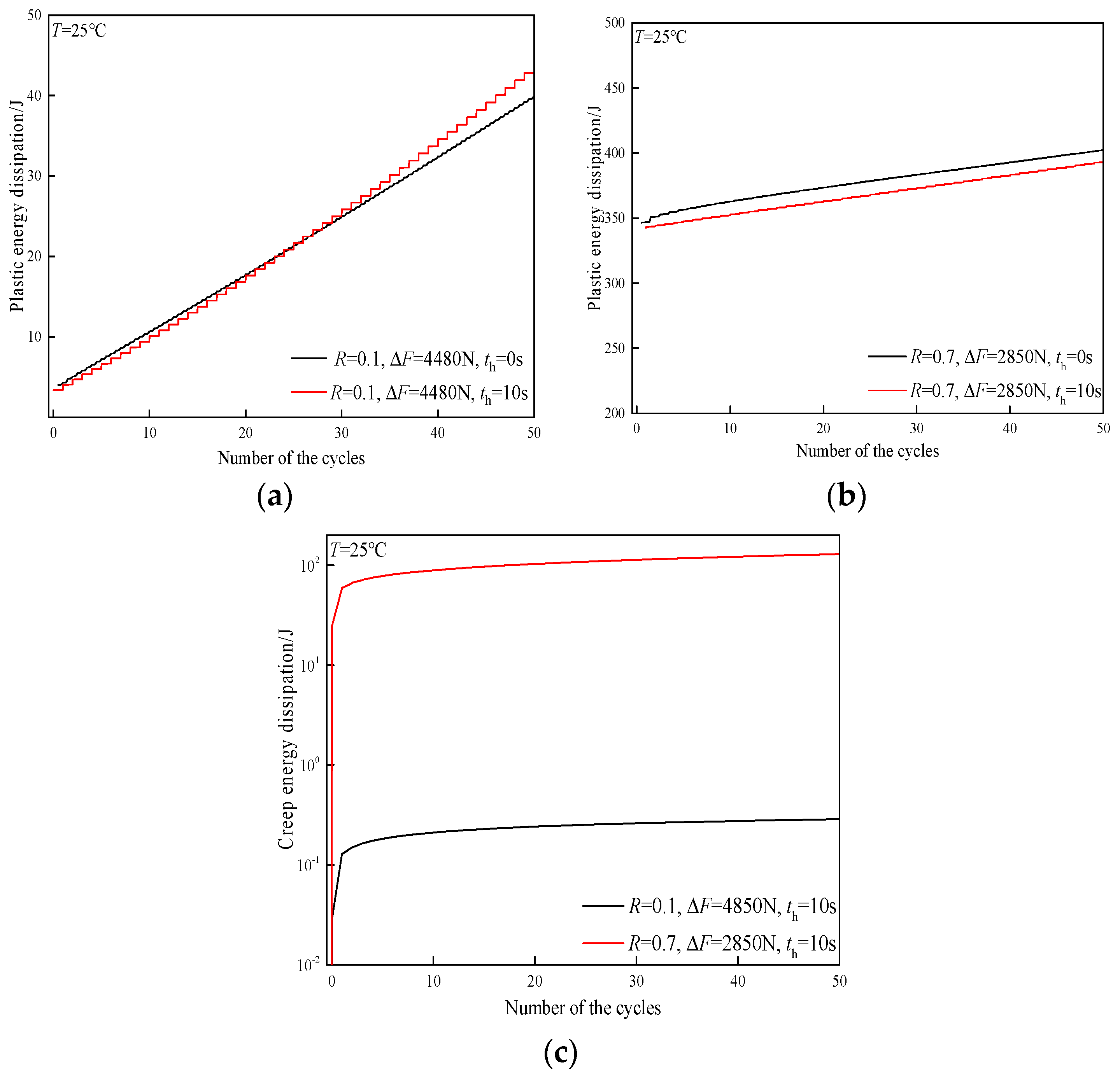
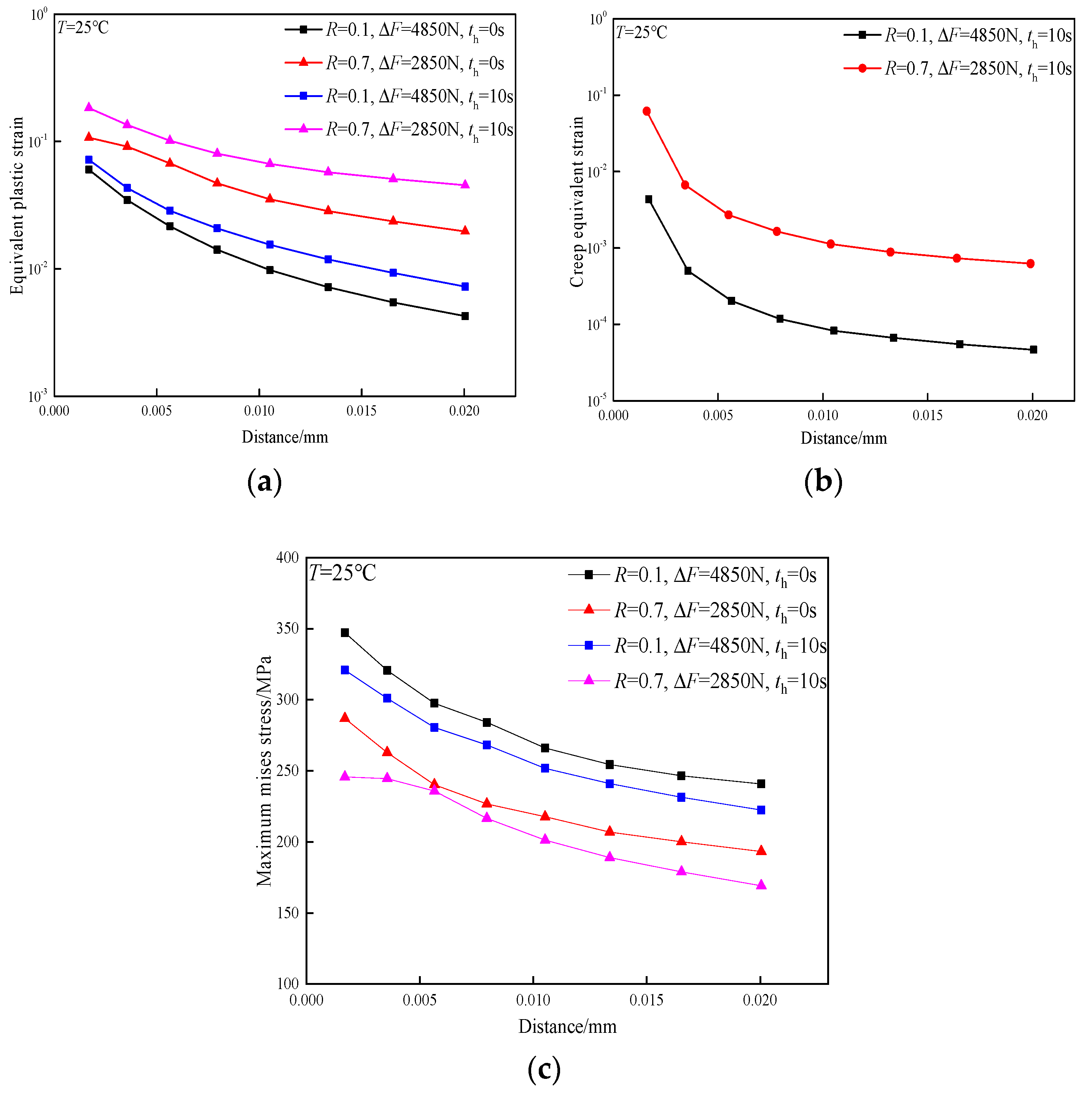
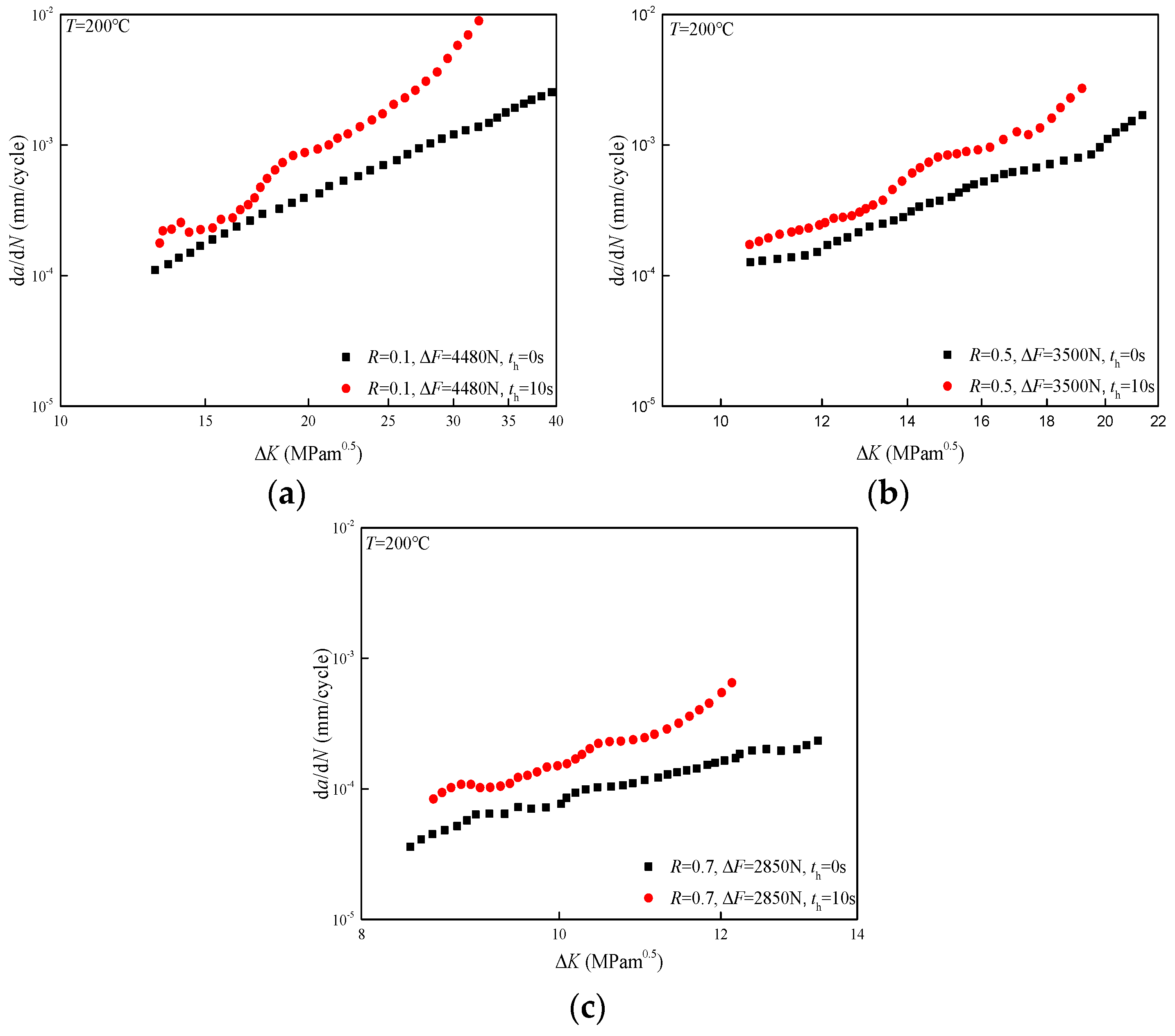
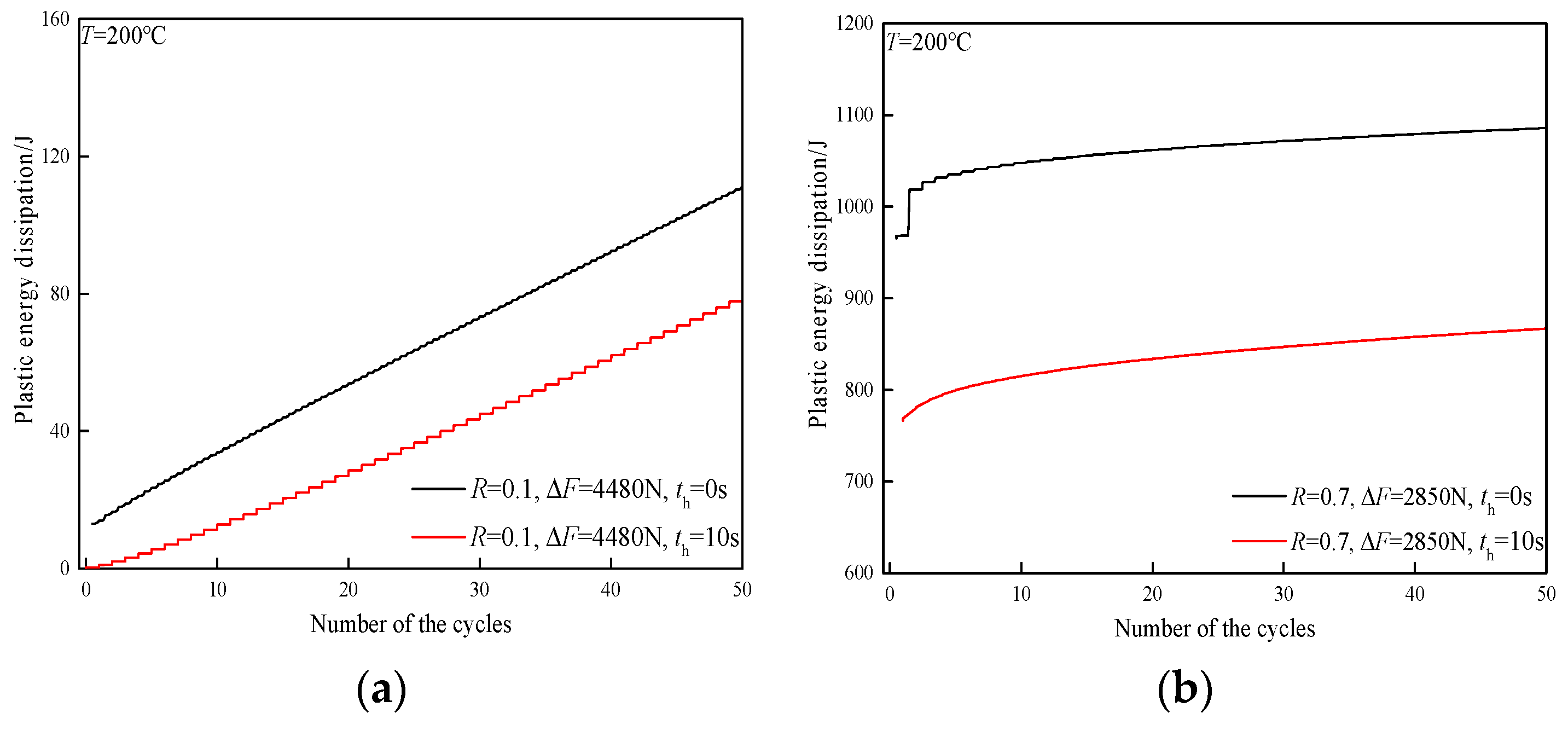
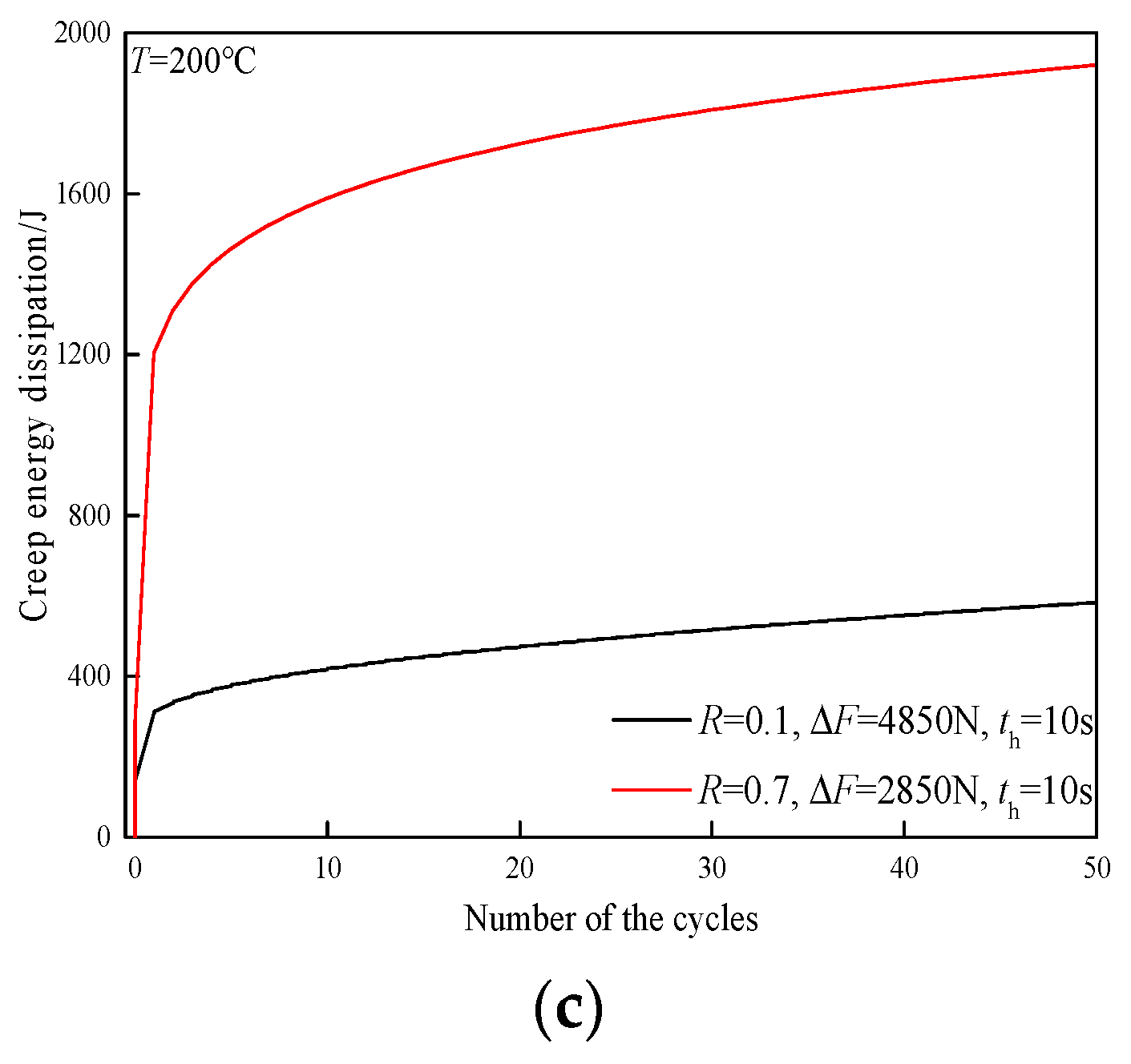


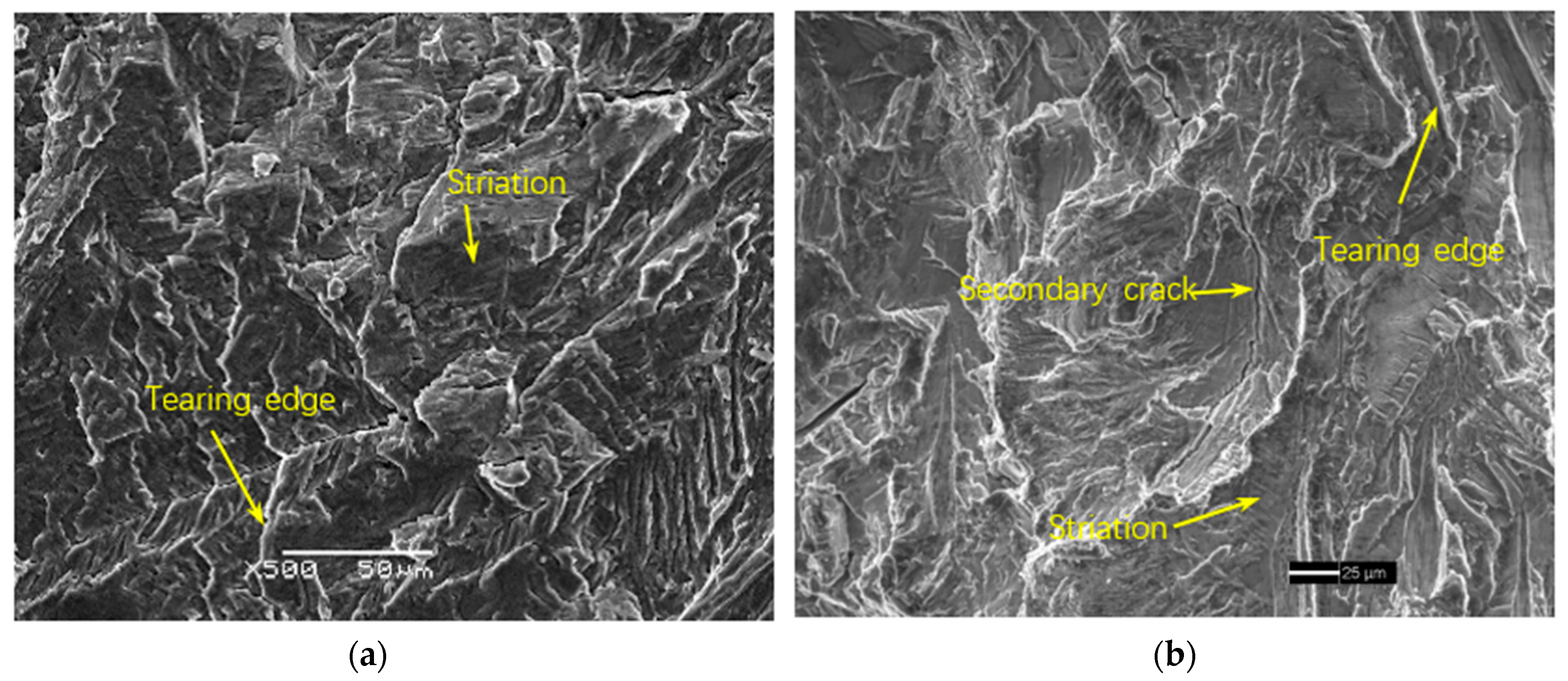


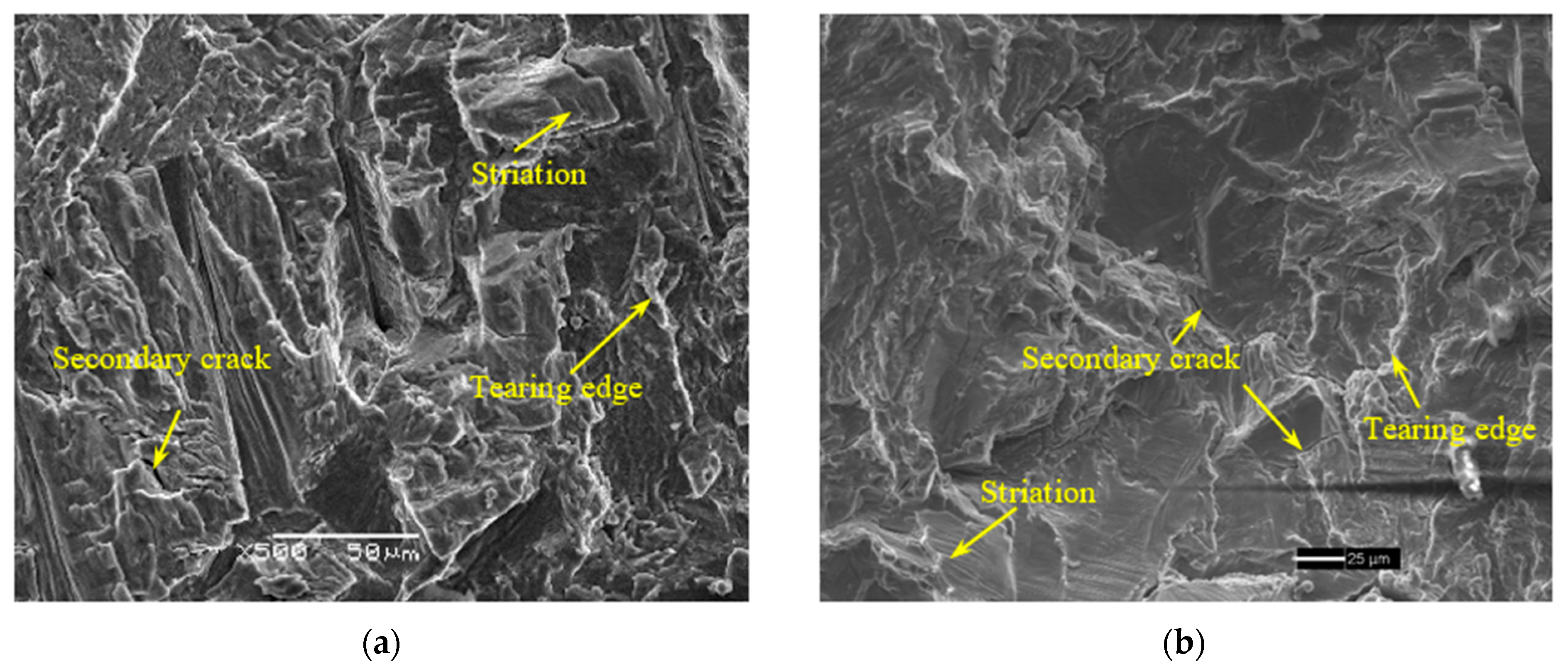
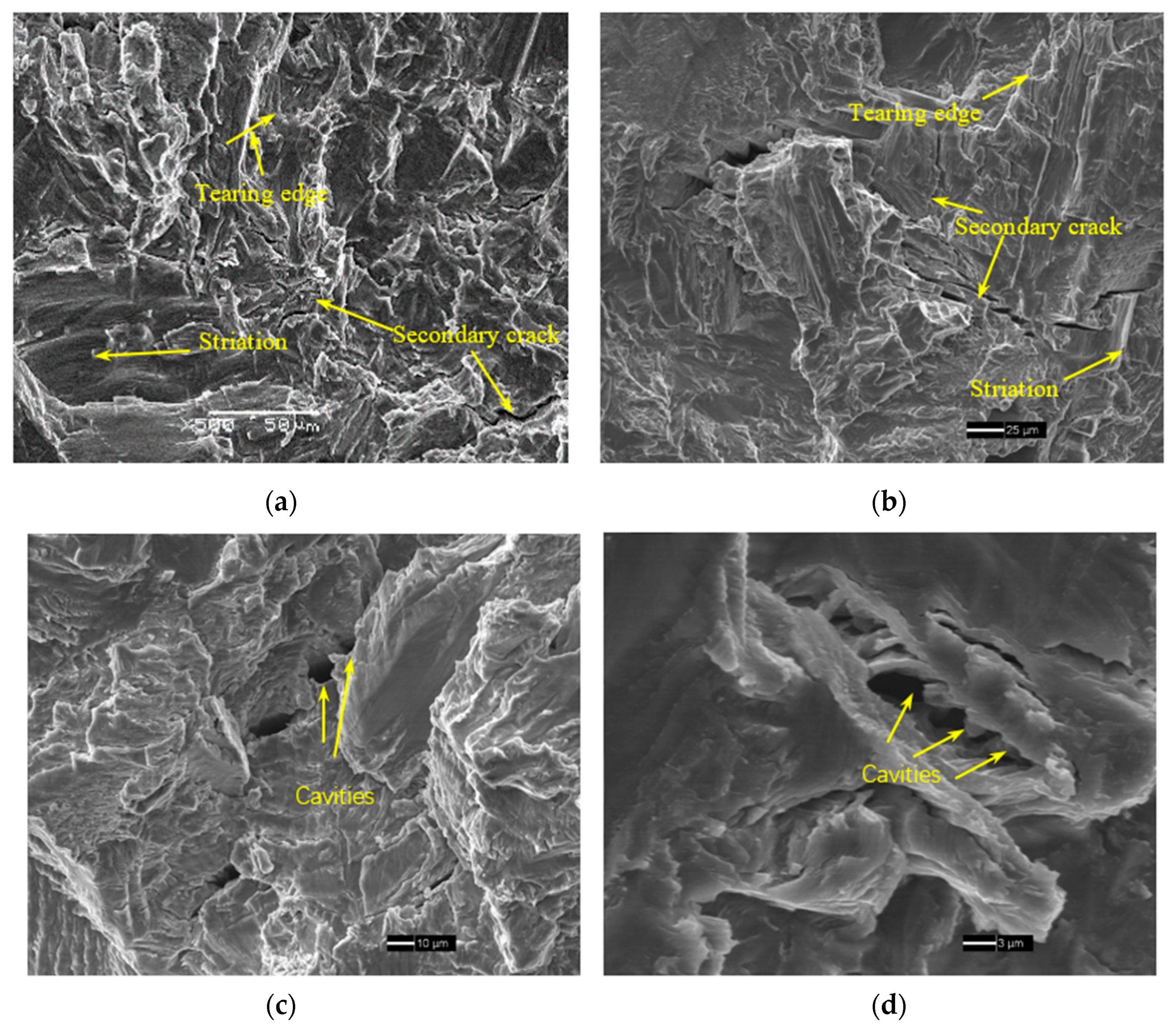
| Fe | C | N | H | O | Ti |
|---|---|---|---|---|---|
| 0.061 | 0.028 | 0.006 | 0.002 | 0.087 | Other |
| Welding Method | Joint Profile | Filler Metal | Acceleration Voltage U (V) | Focus Current If (A) | Welding Speed v/(mm s−1) |
|---|---|---|---|---|---|
| GTAW | X groove | CP-Ti | 13–20 | 160–220 | 1.7–2.5 |
| Specimen No. | Temperature (°C) | Dwell Time (s) | R | Relative Error of R | ∆F (N) | Relative Error of ∆F |
|---|---|---|---|---|---|---|
| W1 | 25 | 0 | 0.1 | 2.78% | 4480 | 8.64% |
| W2 | 25 | 10 | 0.1 | 2.78% | 4480 | 8.71% |
| W3 | 25 | 0 | 0.5 | 0.40% | 3500 | 8.00% |
| W4 | 25 | 10 | 0.5 | 1.23% | 3500 | 8.88% |
| W5 | 25 | 0 | 0.7 | 0.78% | 2850 | 8.81% |
| W6 | 25 | 10 | 0.7 | 0.79% | 2850 | 8.95% |
| W7 | 200 | 0 | 0.1 | 3.54% | 4480 | 8.90% |
| W8 | 200 | 10 | 0.1 | 5.91% | 4480 | 8.92% |
| W9 | 200 | 0 | 0.5 | 0.72% | 3500 | 8.98% |
| W10 | 200 | 10 | 0.5 | 0.95% | 3500 | 8.69% |
| W11 | 200 | 0 | 0.7 | 0.81% | 2850 | 8.82% |
| W12 | 200 | 10 | 0.7 | 0.76% | 2850 | 8.80% |
| T (°C) | σ0 (MPa) | C1 (MPa) | γ1 | C2 (MPa) | γ2 | A | n | m |
|---|---|---|---|---|---|---|---|---|
| 25 | 350 | 413 | 10 | 8802 | 65 | 0.291 × 10−9 | 2.42834 | −0.80059 |
| 200 | 180 | 10077 | 213 | 539 | 9 | 0.3 × 10−17 | 6.78653 | −0.88797 |
Disclaimer/Publisher’s Note: The statements, opinions and data contained in all publications are solely those of the individual author(s) and contributor(s) and not of MDPI and/or the editor(s). MDPI and/or the editor(s) disclaim responsibility for any injury to people or property resulting from any ideas, methods, instructions or products referred to in the content. |
© 2023 by the authors. Licensee MDPI, Basel, Switzerland. This article is an open access article distributed under the terms and conditions of the Creative Commons Attribution (CC BY) license (https://creativecommons.org/licenses/by/4.0/).
Share and Cite
Chang, L.; Lu, L.; Zhou, B.; Zhou, C. Dwell Fatigue Crack Growth Behavior of CP-Ti TA2 Welded Joint at 25 °C and 200 °C. Metals 2023, 13, 553. https://doi.org/10.3390/met13030553
Chang L, Lu L, Zhou B, Zhou C. Dwell Fatigue Crack Growth Behavior of CP-Ti TA2 Welded Joint at 25 °C and 200 °C. Metals. 2023; 13(3):553. https://doi.org/10.3390/met13030553
Chicago/Turabian StyleChang, Le, Lei Lu, Binbin Zhou, and Changyu Zhou. 2023. "Dwell Fatigue Crack Growth Behavior of CP-Ti TA2 Welded Joint at 25 °C and 200 °C" Metals 13, no. 3: 553. https://doi.org/10.3390/met13030553
APA StyleChang, L., Lu, L., Zhou, B., & Zhou, C. (2023). Dwell Fatigue Crack Growth Behavior of CP-Ti TA2 Welded Joint at 25 °C and 200 °C. Metals, 13(3), 553. https://doi.org/10.3390/met13030553






